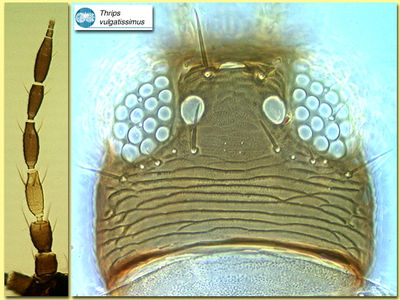Figures
Fig. 1 Antenna and head (dorsal)
Fig. 2 Head and pronotum
Fig. 3 Meso- and metanotum
Fig. 4 Fore and hind wing
Fig. 5 Pleurotergite III
Fig. 6 Sternite VII and VIII (male)
Fig. 7 Sternite VI and VII (female)
Fig. 8 Tergite VIII (female)
Fig. 9 Tergite VIII (female)
Species
Thrips vulgatissimus Haliday
Biology
Apparently particularly common in various white flowers.
Distribution
Widespread in Europe and north America, but found also in Tasmania and New Zealand.
Recognition
Medium to large, dark brown thrips, antennal segment III usually yellow; forewings pale to weakly shaded. Antennae 8-segmented, sense cone on III & IV small and forked. Head with no setae in front of fore ocellus, one pair of long setae on anterior margins of ocellar triangle. Pronotum with 2 pairs of posteroangular setae. Metanotum with transverse lines at anterior but longitudinal lines on posterior half; median setae not at anterior margin. Forewing first vein with 3 or 4 setae on distal half. Tergite II with 3 lateral marginal setae; V-VIII with ctenidia laterally, on VIII posteromesad of spiracle; posteromarginal comb on tergite VIII complete with slender microtrichia. Sternites with transverse row of about 12 discal setae; pleurotergites with 2, 3 or 4 discal setae.
Related species
Closely related to the European species T. atratus and T. meridionalis.










